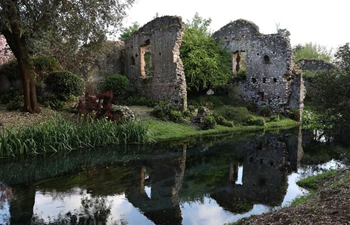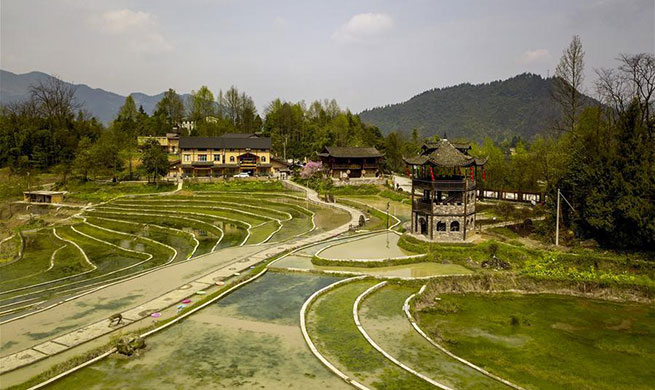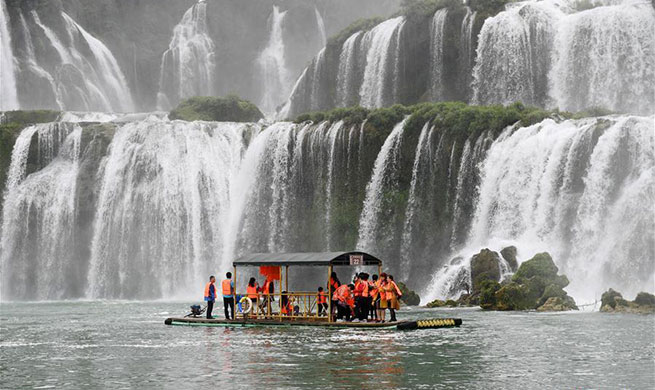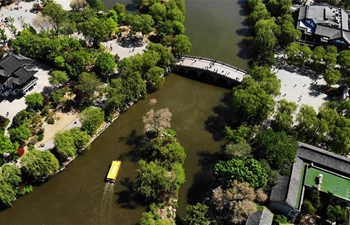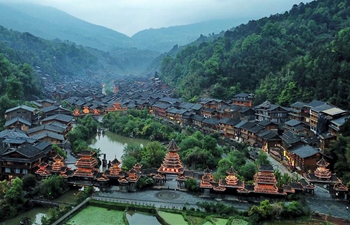By Stefania Fumo
ROME, April 17 (Xinhua) -- As Notre Dame Cathedral burned in Paris, Italians wondered about the safety of their country's churches, works of art, and UNESCO World Heritage sites.
Italy has 4,000 museums, 6,000 archeological parks, 85,000 protected churches, and 40,000 historical homes, according to the Fondo Ambiente Italiano (FAI), known in English as the National Trust of Italy, a non-profit foundation founded in 1975.
A highly seismic country, Italy has suffered a number of destructive earthquakes, and in recent memory, fires destroyed three landmark buildings -- the La Fenice opera theater in Venice in 1996 and the Teatro Petruzzelli in Bari in 1991, both of which were eventually rebuilt, and the baroque Chapel of the Holy Shroud in Turin in 1997, which was restored and reopened in 2018.
Cardinal Angelo Comastri, the Vicar General of the Vatican City, told RAI News 24 public broadcaster on Wednesday that St. Peter's Cathedral, whose construction began in the early 1500s, has very little wood inside it of the kind that caught fire in Notre Dame.
"The choir is made of wood, but the rest is all marble and stucco," he said. "So there is no risk of a fire such as the one in Paris."
"Our firefighters are very well trained and very well equipped, and it would be very hard for a fire to spread here," the cardinal added of St Peter's, one of the largest churches in the world, which houses Michelangelo's famous La Pieta statue, among other treasures.
Another of Italy's famous cathedrals, the Duomo in Milan, whose maintenance costs 15 million euros (16.9 million U.S. dollars) a year, also has less wood than Notre Dame: just the choir and the organ, which has 15,800 pipes.
However authorities there are overhauling the electrical system and improving smoke sensors in the massive basilica, which has caught fire twice so far in its history: once in the 17th century and once in 1969, when a worker left a burning cigarette on a scaffold, RAI reported.
Rome-based "Il Messaggero" newspaper wrote: "according to national security regulations, church buildings are exempt from the obligation of obtaining the so-called Fire Prevention Certificate (CPI) from the fire department".
"However, according to the culture superintendent of the southern cities of Lecce, Brindisi and Taranto, Maria Piccarreta, churches considered to be monumental buildings that contain protected works of art must follow regulations that apply to technical installations (such as electrical wiring)."
Culture Ministry Security Director-General Fabio Carapezza Guttuso told the same paper that "the fire protection plan must be designed like a tailor-made dress", and this is the concept that is being worked on in Italy in the wake of the Notre Dame disaster.
"If the Florence cathedral and Giotto's bell tower don't have a CPI, we still request a consultancy from the fire department," the security director for the Opera del Duomo, Samuele Caciagli, explained.
The Opera del Duomo is the Cathedral Workshop or "works commission" and was founded by the Republic of Florence in 1296 to oversee the construction of the city's cathedral, which was finished in 1436.
Since then, the main task for the Opera del Duomo has been the conservation of these monuments. In 1891, the Opera del Duomo Museum was founded to house the works of art which, through the course of the centuries, had been removed from the cathedral.
"We started with an analysis of present risks, in order to eliminate them with new protection systems," Caciagli explained.
"From lighting sensors under the roofs, to the activation of a large-scale lightning rod that can involve the entire cathedral, making it into a Faraday cage," he said, in reference to the 19th-century device invented by British scientist Michael Faraday, which encloses a space and protects it from lightning and electrostatic discharges.
As far as worksites, Caciagli explained, "When the staff is gone, we turn off the power supply. We are also studying the condition of the wood in the basilica, including the covering of the Giotto bell tower, which has wooden scaffolding."
Vatican Fire Department Major Paolo De Angelis told Il Messaggero that "we have regular meetings" on security because "the timing of the intervention once a fire breaks out is key" and the Rome culture superintendency said that "all the fire protection protocols at active restoration worksites will be reviewed".
In Milan, where the Duomo cathedral is also equipped with sensors and lightning rods, Superintendent Antonella Ranaldi told Il Messaggero that "attention is high" and that authorities have set up a permanent commission made up of engineers, firefighters and culture ministry experts to oversee security. As well, Duomo authorities have launched a project to network Italy's cathedrals in order to share security-related information.
Documentary filmmaker Alberto Angela, who has filmed on the roof of Notre Dame, told La Repubblica newspaper in an interview that the speed with which the fire tore through the UNESCO World Heritage-listed Gothic cathedral of Notre Dame on Monday night "is a warning to us all: we must be aware of how fragile our cultural treasures are".
"Disasters such as this one (the Notre Dame fire) must push us even more to promote their protection and conservation," said Angela, whose award-winning documentaries have explored the worlds of nature, art, archeology, and science.
In an interview also with La Repubblica, art historian Antonio Paolucci, a former culture minister, Vatican Museum director, and commissioner for the restoration of the Assisi basilica after it was damaged by an earthquake in 1997, said that Notre Dame should be rebuilt exactly as it was, "like La Fenice in Venice and the Petruzzelli Theater in Bari".
Italian starchitect Renzo Piano agreed with Paolucci. In an interview with Corriere della Sera paper, he said the burned-out roof of Notre Dame, which was first built around the year 1160 with the wood of 13,000 trees from medieval forests, should be rebuilt exactly like the original -- in wood.
"People think wood structures are dangerous because they burn, but this is more likely to happen with very ancient wood that has not been treated to be fire-retardant," Piano told Corriere. "Whoever reconstructs Notre Dame, will use wood that has been treated with scientifically modern methods, maintaining continuity with history."
Piano added that "we must stop talking about fatality, because worksite accidents are not fatalities -- they can be avoided. What happened in Notre Dame...is a dramatic thing, and tragedies can be avoided."
Giuliana Cardani, who teaches restoration at Milan's Polytechnic University, told ANSA news agency in an interview that Italy's experience of rebuilding after earthquakes "has taught us that modern technology must adapt itself very carefully to ancient structures".
"Everything can be rebuilt: history has taught us this many times," Cardani told ANSA.



